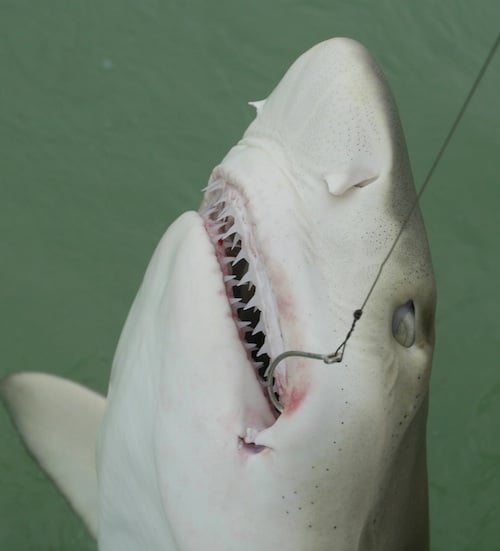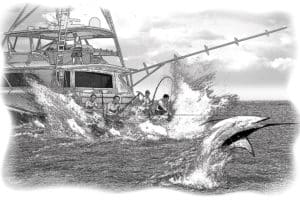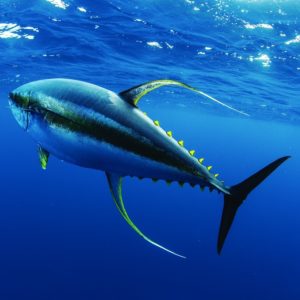
Lemon Shark
In case you haven’t been paying attention, there’s been a hotly contested battle raging lately over the subject of sharks — specifically, whether anglers should keep them or not. Well, don’t look now, but that conversation is about to heat up in a big way.
The National Marine Fisheries Service just released a new draft management plan for sharks caught in the Atlantic Ocean, Gulf of Mexico and the Caribbean Sea. At the heart of NMFS’s plan is a substantial increase in the minimum size limit for any recreationally caught shark, from 4 ½ feet to 8 feet long, a nearly 100 percent increase that’s all but assured to get the attention of anglers on both sides of the issue.
Dubbed Amendment 5 to the Consolidated Atlantic Highly Migratory Species Fishery Management Plan, NMFS’s proposal has been in the works for more than a year, and it marks the first broad-based plan for sharks in these waters in 13 years. Five alternatives are currently being weighed under the plan. They are as follows:
Alternative 1 – Status quo; no change to the current recreational regulations, in place since 1999.
Alternative 2 – Raising minimum fork length for all sharks to 96 inches (8 feet), up from 54 inches (4½ feet). Also, mandatory reporting for all recreationally caught hammerhead species.
Alternative 3 – No change in minimum fork length (54 inches) for all shark species, except for hammerhead sharks, which would be raised to 78 inches (6½ feet), with mandatory reporting for that species as well.
Alternative 4 – Establishment of species-specific recreational shark quotas, based on angler catch limits, with prohibited recreational landings of blacknose sharks.
Alternative 5 – Establishment of strict no-take regulations, both for recreational and commercial fishermen.
NMFS’s preferred alternative is No. 2, which ranks as the second-most restrictive of the bunch (behind No. 5, stipulating no-take). The blanket, 8-foot minimum-size limit it would establish for all species is based off recent woeful size and maturity assessments of the slow-growing dusky shark, which has been prohibited from recreational and commercial catch since 1999.
“We try to have a reason for the particular minimum size limits we establish, and in this particular case, the assessment for dusky sharks was not good,” Karyl Brewster-Geisz, NOAA shark-fishery management specialist tells Sport Fishing. “They’re overfished and overfishing is occurring, despite the fact they are prohibited from being caught. This really concerns us. We’re not doing this lightly, and we realize it could potentially have a lot of impact with recreational fishermen.”
Some of that angst spilled over recently in a Washington Post article on the subject.
Increasing the minimum size for so many species would effectively “shut down the recreational fishery,” Mark Sampson, an Ocean City, Maryland, charter-boat captain who runs a shark tournament each June told the Post. “I’m all in favor of doing what it takes to protect dusky sharks. However, this isn’t the way to do it.”
Brewster-Geisz tells Sport Fishing that NMFS is taking all this into consideration. “We have a history of making a lot of changes based on public comment,” she says. “We encourage that, and are planning a number of public hearings up and down the coast and in Florida and the Gulf of Mexico.”
She also notes that blanket size limits for all species are instituted because “many recreational fishermen often do not know how to identify species of sharks. We’re aiming this at all recreational fishermen.”
By setting a one-size-fits-all minimum size limit for all species, there is no confusion as to whether a shark is legal or not. That’s the theory, anyway, and the current blanket 4½-foot minimum length established in 1999 (which holds for all species except the tiny bonnethead and Atlantic sharpnose) was based off poor stock assessments of the sandbar shark.
But such a dramatic size increase across the board — while certainly good news to strict conservation-minded anglers — is sure to raise the hackles of at least some sectors of sport fishermen, and leads to the question of whether NMFS might consider size-limit exceptions to some species that are commonly kept recreationally, such as mako sharks or thresher sharks in the Northeast.
“Yes, definitely,” says Brewster-Geisz. “The problem we have is that when you start making too many exceptions, the rules become too complex. But that doesn’t mean we can’t make exceptions, as long as they’re reasonable.”
The draft proposal is open for public comment until Feb.12, 2013, and expected to be finalized by the end of April.
You can click here to read the plan in its entirety (600 pages). For an abridged version of NMFS’s preferred alternative – and to submit comments to NMFS – click here.
We’d also like to hear your comments below – how would a minimum-size limit of 8 feet affect your shark fishing?







